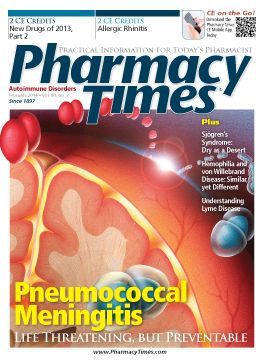Publication
Article
Pharmacy Times
APS: More than Just a Thrombophilia


Management of rare diseases and conditions can be challenging. Antiphospholipid antibody syndrome (APS) can be classified as a disease state with many variables that is still somewhat rarely identified. Therapeutic decisions should center on properly assessing the procoagulant state while balancing the risks of anticoagulant therapy. A laboratory profile should be assessed, and the presence of associated autoimmune disease and other risk factors for venous or arterial thrombosis, as well as pregnancy loss, should all be considered.
APS is a prothrombotic systemic autoimmune disorder that is characterized by venous and/or arterial thrombosis or obstetric morbidity, accompanied by the presence of elevated or positive results of one of the antiphospholipid antibodies (aPLs) on 2 or more occasions at a minimum of 12-week intervals. APS can affect people of all ages and is more common in women than in men. Individuals who have rheumatic or autoimmune disorders are also more likely to be diagnosed with APS.1
Although detection of aPL is required for a diagnosis of APS, a gold standard has not been identified, and standardization of the solid-phase assays remains behind.
There are multiple forms of APS. The most common form is acquired thrombophilias, in which aPLs are present in 1% to 5% of the population. However, only a small number of these patients will receive an APS diagnosis. Those diagnosed are susceptible to recurrent thrombosis.2 Arterial or venous thrombosis of small vessels is a major characteristic and cause of death in this population.3 Catastrophic APS, which is a more rare and life-threatening form of APS occurring in less than 1% of the APS population, is characterized by rapid development of thrombosis that affects multiple organs and leads to organ failure.2,3
The Euro-Phospholipid Project looked at a cohort of 1000 patients and recorded the most common manifestations.4 After a 5-year follow-up of the 1000 patients, new manifestations such as thrombocytopenia livedo reticularis appeared.5
There is no cure for APS; however, there are multiple treatment options. Some treatment modalities are nonanticoagulation therapy, anticoagulant treatment options, and elimination of aPL. High-dose steroids, immunosuppressive therapy, or plasma exchange may decrease or eliminate aPL. Unfortunately, these treatment options are only recommended in special situations because aPL may return upon cessation of therapy and result in “rebound” thrombosis in the first 6 months after discontinuing therapy.3
Some nonanticoagulant treatment options include the use of HMG Co-A reductase inhibitors (ie, “statins”) and rituximab. Statins potentially have a role in treating APS due to their anti-inflammatory, anticoagulant, and immunoregulatory effects. Rituximab has been used in patients with refractory APS; however, it has not been approved for this indication.
The mainstay of treatment of APS is anticoagulation. The preferred agent, intensity, and length of treatment remain controversial, particularly in individuals with prior arterial thrombosis.6 Patients are at an increased risk for bleeding due to the manifestation of thrombocytopenia. Two randomized controlled trials compared standard-intensity vitamin K antagonist (VKA) therapy (international normalized ratio [INR]: 2.0 to 3.0) with high-intensity VKA therapy (INR: 3.1 to 4.0) in patients with APS after their first venous thrombosis event. Study results indicated no difference in rates of recurrent thrombosis or major bleeding, thus supporting the use of standard-intensity anticoagulation.7,8 The optimal duration is typically long term due to the high risk of thombotic recurrence after cessation of therapy.9 Patients with APS and their first arterial thrombosis should receive anticoagulant therapy (INR target range: 2.5 to 3.5) or anticoagulant therapy (INR target range: 2.0 to 3.0) plus aspirin.10 Notably, while novel anticoagulant therapies have established uses in other thrombosis-related disorders, their place in treating APS has not been sufficiently studied. With prospective clinical studies under way, the future may be optimistic.11
APS is underdiagnosed, and a diagnosis is often not made until the patient has had a thrombotic event or obstetric complication. With difficulties identifying APS patients at risk for thrombosis complications, primary prevention is pertinent in asymptomatic aPL-positive patients, individuals with systemic lupus erythematosus, and obstetric APS patients. Adequate secondary prophylaxis must be ensured in patients who have had prior episodes.
Dr. Resseguie is an advanced practice anticoagulation pharmacist for the Brigham & Women’s Hospital Anticoagulation Management Service in Boston, Massachusetts.Kevin Dube is a PharmD candidate at Northeastern University in Boston, Massachusetts.
References
- Who is at risk for antiphospholipid antibody syndrome? National Heart, Lung, and Blood Institute website. www.nhlbi.nih.gov/health/health-topics/topics/aps/atrisk.html. Accessed February 5, 2014.
- Gomez-Puerta JA, Cervera R. Diagnosis and classification of the antiphospholipid Ì syndrome [published online January 22, 2014]. J Autoimmun.
- Danowski A, Rego J, Kakehasi AM, et al. Guidelines for the treatment of antiphospholipid syndrome. Rev Bras Reumatol. 2013;53(2):184-192.
- Cervera R, Piette JC, Font J, et al. Antiphospholipid syndrome: clinical and immunologic manifestations and patterns of disease expression in a cohort of 1,000 patients. Arthritis Rheum. 2002;46:1019-1027.
- Cervera R, Khamashta MA, Shoenfeld Y, et al. Morbidity and mortality in the antiphospholipid syndrome during a 5-year period: a multicentre prospective study of 1000 patients. Ann Rheum Dis. 2009;68:1428-1432.
- Lim W. Antiphospholipid syndrome. Hematol Am Soc Hematol Educ Program. 2013;2013:675-680.
- Crowther MA, Ginsberg JS, Julian J, et al. A comparison of two intensities of warfarin for the prevention of recurrent thrombosis in patients with the antiphospholipid antibody syndrome. N Engl J Med. 2003;349(12):1133-1138.
- Finazzi G, Marchioli R, Brancaccio V, et al. A randomized clinical trial of high-intensity warfarin vs. conventional antithrombotic therapy for the prevention of recurrent thrombosis in patients with the antiphospholipid syndrome (WAPS). J Thromb Haemost. 2005;3(5):848-853.
- Schulman S, Svenungsson E, Granqvist S. Anticardiolipin antibodies predict early recurrence of thromboembolism and death among patients with venous thromboembolism following anticoagulant therapy. Am J Med. 1998;104(4):332-338.
- Ruiz-Irastorza G, Cuadrado MJ, Ruiz-Arruza I, et al. Evidence-based recommendations for the prevention and long-term management of thrombosis in antiphospholipid antibody-positive patients: report of a task force at the 13th International Congress on antiphospholipid antibodies. Lupus. 2011;20:206-218.
- Arachchillage D, Cohen H. Use of new oral anticoagulants in antiphospholipid syndrome. Curr Rheumatol Rep. 2013;(6):331.







